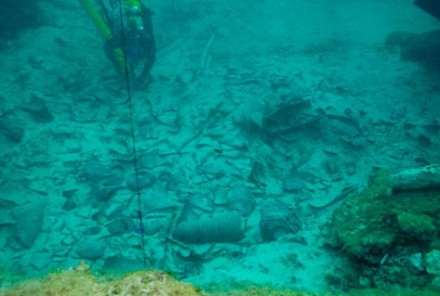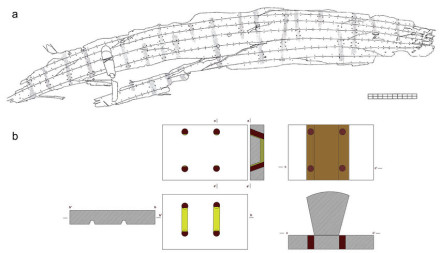History
Very early shipwreck
In 1973 a wooden shipwreck was discovered near the ancient port of Sanitja on the island of Menorca. It was identified as a Phoenician or Punic ship. Over 150 Punic amphorae were still found in situ. It became known as the Binissafúller shipwreck, after a nearby beach. The amphorae have been dated between 325 and 275 BC, making the shipwreck the oldest documented wreck in the region.

Historical background
Sanitja, along with the surrounding area, was conquered by the Romans in 123 BC, because of its ideal position as a natural anchorage on the north coast of Menorca. It had been a popular place for sailors before that, also for the Phoenicians.
The Punics, also called Western Phoenicians, were a group of western Semitic-speaking peoples from Carthage in Northern Africa who traced their origins to a group of Phoenician settlers, but also to North African Berbers. They were widely active in and around the Mediterranean, settling in various places.
Description

References
- De Nicolás, Juan C. (1973).
État actuel de l'archéologie sous-marine à Minorque.
Cahiers d'Archéologie subaquatique II.
pp 167-174. - Fernández-Miranda, Manuel; Belén, María. (1977).
El barco de Binissafúller.
Arqueología Submarina en Menorca, 69-82. Fundación Juan March, Menorca. - Guerrero, Víctor; Miró, Jordi; Ramón, Joan. (1991).
El pecio de Binissafúller (Menorca), un mercante púnico del siglo III a.C.
Meloussa, 2.
pp 9-30. - Guerrero Ayuso, Víctor M.; Quintana, Carles. (2000).
Comercio y difusión de ánforas ibéricas en Baleares.
Quaderns de prehistòria i arqueologia de Castelló, 21.
pp 153-188. - Tejedor, R. (1978).
Yacimientos de Binissafúller.
Excavaciones submarinas en Menorca. Mahon. - Aguelo, Xavier; Palomo, Antoni; Pons, Octavi; Juan, Carles de. (2008).
La excavación del pecio de Benissafúller (Menorca).
Actas V Jornadas de Arqueología Subacuática. - De Juan, Carles; Aguelo, Xavier; Palomo, Antoni; Pons, Octavi. (2010).
La construcción naval del pecio de Binissafúller (Menorca-Islas Baleares). Análisis de los restos de casco conservados.
Publications de l'Institut Français d'Études Anatoliennes, 20.
pp 59-73. - Aguelo, Xavier; Pons Machado, Octavi; De Juan Fuertes, Carlos; Torres, Joan Ramón; Mata Parreño, Consuelo; Soria Combadiera, Lucía; Piqué i Huerta, Raquel; Antolín i Tutusaus, Ferran. (2013).
El pecio de Binissafúller. Estado de las investigaciones.
Arqueología subacuática española: Actas del I Congreso de Arqueología Naútica y Subacuática Española, vol. 1: 65-78. - De Juan, Carlos (2014).
Les épaves de Mazarron et de Binissafuller - La tradition ibérique d’influence punico-phénicienne.
Dossiers d'Archéologie, 364.
pp 26-33. - Ancient Origins.
2,300-year-old Punic Vessels uncovered in ancient shipwreck.